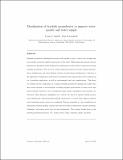Desalination of brackish groundwater to improve water quality and water supply
Author(s)
Ahdab, Yvana D; Lienhard, John H
DownloadAhdab-Lienhard-Groundwater_Desalination_Chapter-R1.pdf (1.332Mb)
Open Access Policy
Open Access Policy
Creative Commons Attribution-Noncommercial-Share Alike
Terms of use
Metadata
Show full item recordAbstract
Brackish groundwater desalination has and will continue to play a critical role in improving
water quality and water supply in many parts of the world. While numerous methods exist for
desalination, membrane-based desalination technologies are used without exception in treating
brackish groundwater. The two most widely adopted processes are reverse osmosis (pressure-
driven desalination) and electrodialysis (electric potential-driven desalination). Selection of
the appropriate technology is made based on feedwater and target product water composition
for a particular application, as well as environmental and cost considerations. This chap-
ter outlines the key components of a typical brackish groundwater desalination facility that
uses reverse osmosis or electrodialysis, including required pretreatment of source water and
post-treatment of product water. Desalination plant energy consumption and economics are
discussed. Brine disposal is highlighted as a critical cost driver for inland brackish ground-
water desalination. Environmentally-friendly alternatives to current brine disposal methods
and conventional energy sources are considered. Because geography is a key consideration in
desalination decision-making, regional and national trends in desalination capacity, spending,
technology, and source water type are also investigated. The national trends focus on the
following desalination players: U.S., Saudi Arabia, China, Australia, Spain, and India.
Date issued
2020Department
Massachusetts Institute of Technology. Department of Mechanical Engineering; Rohsenow Kendall Heat Transfer Laboratory (Massachusetts Institute of Technology)Journal
Global Groundwater: Source, Scarcity, Sustainability, Security and Solutions
Publisher
Elsevier
Citation
Ahdab, Yvana D. and John H. Lienhard. "Desalination of brackish groundwater to improve water quality and water supply." Global Groundwater: Source, Scarcity, Sustainability, Security and Solutions, edited by Abhijit Mukherjee et al, Elsevier, forthcoming. © 2021 Elsevier
Version: Author's final manuscript
ISBN
978-0128181720